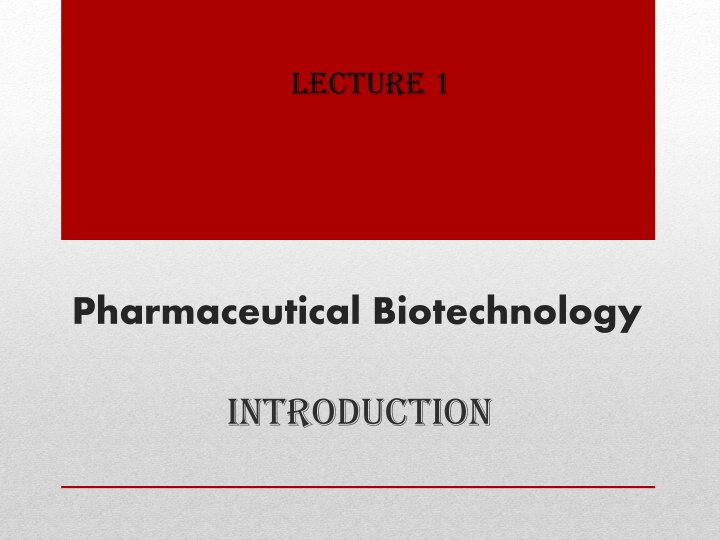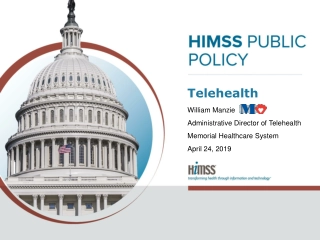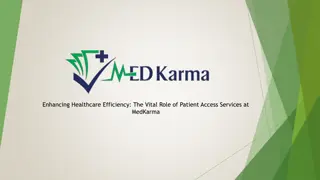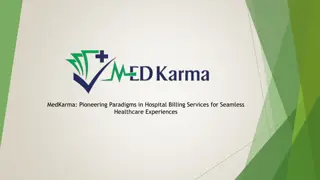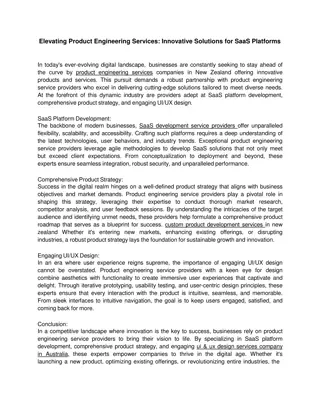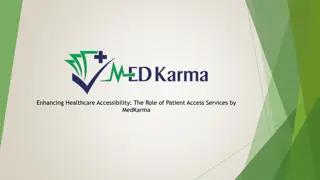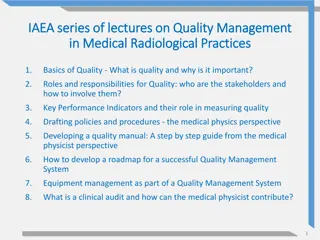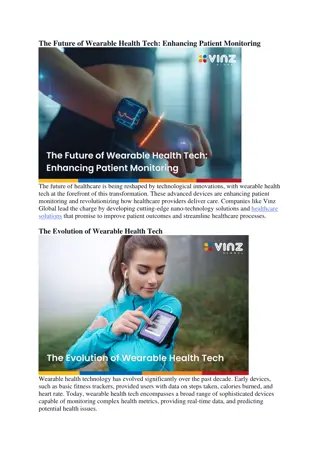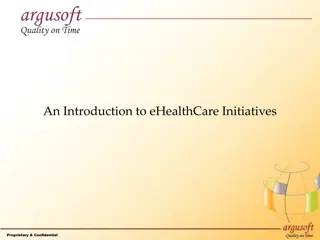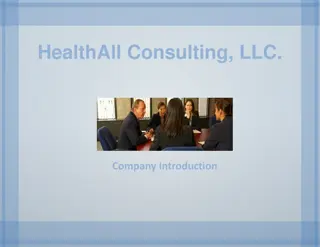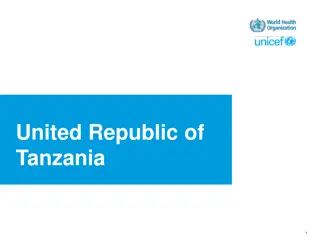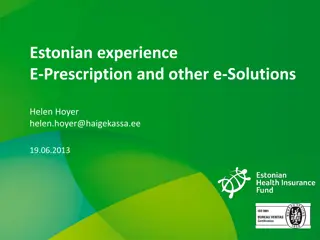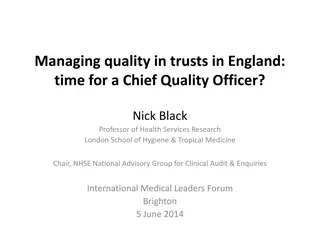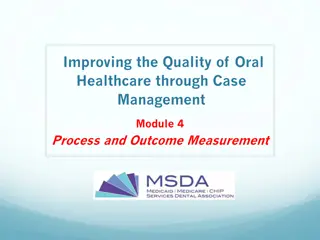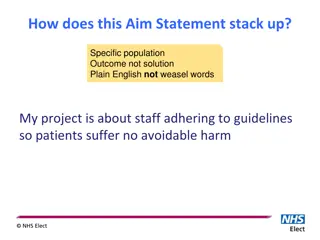Enhancing Quality Healthcare Services through Innovative Solutions
Offering a visual journey through a series of slides showcasing various aspects of quality healthcare services and innovative solutions. The images reflect a commitment to excellence in healthcare delivery and technology integration. From registration processes to resource centers and portals, each slide represents a step towards enhancing the overall quality of healthcare services. Explore the modern tools and platforms designed to streamline patient care and improve healthcare outcomes.
Download Presentation

Please find below an Image/Link to download the presentation.
The content on the website is provided AS IS for your information and personal use only. It may not be sold, licensed, or shared on other websites without obtaining consent from the author.If you encounter any issues during the download, it is possible that the publisher has removed the file from their server.
You are allowed to download the files provided on this website for personal or commercial use, subject to the condition that they are used lawfully. All files are the property of their respective owners.
The content on the website is provided AS IS for your information and personal use only. It may not be sold, licensed, or shared on other websites without obtaining consent from the author.
E N D
Presentation Transcript
Lecture 1 Pharmaceutical Biotechnology Introduction
Biotechnology It implies with the use of microorganisms, plants, animals or parts of them for the production of useful compounds. Pharmaceutical biotechnology It manufacturing of pharmaceutical products. is concerned as the biotechnological
Biotechnology Biotechnology in ancient times E.g. Making wine from grapes. Based merely experience in bioproducts for many ages homemade in a traditional fashion without an understanding of the underlying principles An insight into the nature of the traditional processes was achieved in about 1870. Pasteur illustrated that chemical conversions in these processes were performed by living cells, and thus the traditional processes should be consider biochemical conversions.
Biotechnology becomes a science! Decades following Pasteur's discovery, biotechnological knowledge increased when the catalytic role of enzymes for most biochemical conversions became apparent, based on that knowledge tools became available for the control and optimization of the traditional processes. Catalysis Catalysis: : An alternative fast reaction pathway for the production of more stable products than the starting material and has a lower activation energy than the reaction route not mediated by the catalyst. E.g. The disproportionation of hydrogen peroxide creates water and oxygen due to the role of peroxidase enzyme in organisms, as shown below. 2 H2O2 2 H2O + O2
A further and very important breakthrough took place after the development of (Molecular Biology). The notion or concept, brought forward by the pioneers in the molecular biology in around 1950, that DNA encodes proteins and in this way controls all cellular processes was the impetus for a new period in biotechnology.
The fast evolving DNA technologies, after the development of the recombinant DNA technology in 70th, allowed biotechnologists to control gene expression in the organisms used for biotechnological manufacturing. These developed technologies opened new ways for the introduction of foreign DNA into all kinds of organisms. Thus genetically modified organisms constructed in this way to open up completely new possibilities for biotechnology.
Molecular biotechnology A new form of biotechnology, based on thorough knowledge of DNA molecule and the availability technologies of DNA. of manipulation Biotechnology became the subject of public debate An important question in debate deals with potentials risks: do genetically modified organisms used in production facilities pose unknown risks for the ecosystem and for the human race itself? Moreover, a profound ethical question was brought forward: is it right to modify the genetic structure of living organisms?
Gene Expression Genetic information, chemically determined by DNA structure, that is transferred during cell division to daughter cells by (DNA replication) expressed by transcription (conversion of DNA into RNA) followed by translation (conversion of RNA into protein) Series of events DNA RNA Protein
Biopharmaceutical Drugs Conventional pharmaceutical formulations Are relatively simple molecules manufactured mainly for treating through trial and error technique for treating the symptoms of a disease or illness. Biopharmaceuticals Complex biological molecules, commonly known as proteins that usually aim at eliminating the underlying mechanisms for treating diseases.
Note: Biotechnology and traditional drugs Difference between Pharmaceutical Essentially used to make (Complex Larger Molecules) with the help of living cells (like those found in the human body such as bacteria cells, yeast cells, animals or plant cells). Unlike the smaller molecules that are given to a patient through tablets, the large molecules are typically injected into the patient s body.
Pharmaceuticals and Biotechnology- Benefits of Combination When the two disciplines -pharmaceuticals and biotechnology- come together, they result in many advantages for humankind in terms of healthcare. 1- Biopharmaceutical drugs aim to designing and producing drugs that are adapted to each person s genetic makeup. Thus pharmaceutical biotechnology companies develop tailor-made medicines for maximum therapeutic effects. 2- Better vaccines in the form of Pharmaceutical biotechnology. Biotech companies design and produce safer vaccines by organisms that are transformed through genetic engineering thus minimizing the risks of infection.
Pharmaceutical Biotechnology Products Antibodies, Proteins and Recombinant DNA products Antibodies- are proteins produced by white blood cells and are used by immune system to identify bacteria, viruses and other foreign substances and to fight them off. Monoclonal antibodies- are one of the most exciting developments in pharmaceutical biotechnology at these recent years. (produced as a result of perpetuating the expression of a single beta lymphocyte. Consequently, all of the antibody molecules secreted by a series of daughter cells derived from a single dividing parent beta lymphocyte are genetically identical).
Proteins- made of amino acids or large, complex molecules that do most of the work in the cells and are required for the structure, function, and regulation of the body s tissues and organs. Protein biotechnology- is emerging as one of the key technologies of the future for understanding the development of many diseases like cancer or amyloid formation for better therapeutic intervention.
Recombinant DNA products- Recombinant Deoxyribonucleic acid is the genetically engineered DNA created byrecombining fragments of DNA from different organisms. Some Some of of the Recombinant DNA Vaccines Recombinant DNA Drugs Recombinant DNA Enzymes Recombinant DNA Growth Hormones Recombinant DNA Insulin Recombinant DNA Proteins Recombinant DNA Yeast the Recombinant Recombinant DNA DNA Products Products include include: :
Recombinant DNA Technologies Genetic modification of organisms is done by Fusion of any DNA fragment to DNA molecules able to maintain themselves by autonomous replication. Such molecules called replicons
Recombinant DNA Plasmid or Vector
Thus Recombinant DNA technology or DNA cloning technology: (Application of plasmids in biotechnology) Fusing foreign DNA fragment to the isolated plasmid in order to create a recombinant DNA molecule called replicons. Replicons used as carriers for foreign DNA fragments are termed vectors (include plasmids from bacteria or yeast, or DNA from bactriovirus, animal virus or Plant virus). Foreign DNA Foreign DNA- isolated either from microbial, plant or animal cell
Note: -Restriction enzyme used to cut DNA at a specific site. -Ligase enzyme used to close circular recombinant DNA. - Introduction of recombinant DNA into host cell leads to form (Transformant). - Vector replicate in the host, thus all daughter cells will inherit precise copy (a clone) of the recombinant DNA molecule.
Monoclonal Antibodies Typically made by fusing myeloma cells with the spleen from a mouse that has been immunized with the desired antigen.
